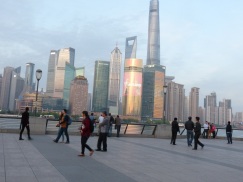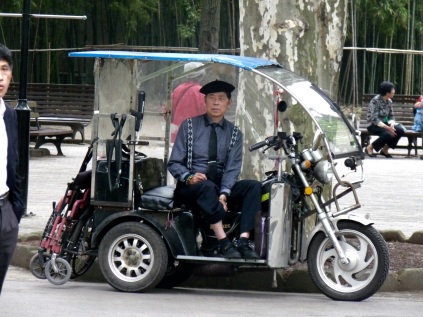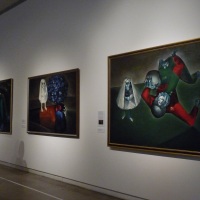I’ve just returned from a week in Shanghai. I’d not been to China prior to this trip and had been told that Shanghai was a good place to start for a first time visitor to this very large and intriguing country. Getting around Shanghai is quite easy. Taxis are cheap – around $40AUD from the airport to my hotel in the centre of the city which took about 45 minutes. The Metro public train system is also very cheap – less than $1AUD a trip – and super easy to use. The ticket machines have an English translation as do all signs and announcements on the trains and stations, and everywhere else in the city for that matter.
My hotel was in a great location, next to the traditional Yuyuan Gardens and a 10-15 minute walk to The Bund. A metro station was a 2 minute walk away which meant I could get to anywhere in Shanghai quickly and easily. The traffic however, particularly the bicycles and motor scooters, took a bit of getting used to. There are no rules for these guys, even when they’re on a red traffic light, they keep on coming. I quickly learned to walk at an even pace across the road and they’ll go around you.
The Bund is a waterfront area in central Shanghai within the former Shanghai International Settlement, which runs along the bank of the Huangpu River and faces Pudong, the business and technology precinct. The viewing platform runs for over a kilometre and sits before a large number of beautiful buildings of different architectural styles, most predominantly the Art Deco style (Shanghai has one of the best collections of Art Deco architectures in the world).
I’d been told by a number of people that I should visit The Bund but I don’t think I was prepared for how spectacular it is. The downside is that it is overrun by tourists most days but is definitely worth the effort. The buildings behind are magnificent and the view to Pudong is stunning although a little kitschy at night when some of the buildings are lit up with advertising and ‘I heart SH’.
Shanghai has the most beautiful parks and gardens and each day and night the locals fill them, dancing, singing karaoke, flying kites, playing cards or checkers, knitting, gossiping, fishing, playing basketball … and so many other activities.
A tour of the French Concession area was a great way to learn about that era of local history and to see some of the art deco architecture that Shanghai is famous for. My favourite building was the stunning Garden Hotel, built in 1926 as the French Sports Club (or Cercle Sportif Francais). Unfortunately its life as a French Sports Club ended when the Japanese invaded during WW2 and the building was used as their headquarters for a short period before the US took it over for a period after the war. Then came the Cultural Revolution when it became the People’s Culture Palace and Chairman Mao’s home for a short time. As the Garden Hotel it retains most of its art deco grandeur including a massive ballroom that is used for weddings and large functions.
I also did a shopping tour. As luck would have it I was the only one on the tour and so I had a wonderful day touring the city with Suzy, a New Zealander who has lived in Shanghai for around eight years and knows it intimately. As well as getting great shopping tips I learned lots about local culture and customs. Did you know that most Chinese babies are toilet trained by their grandmothers by the time they’re eight weeks old?
We visited the South Bund Fabric Market where you can get pretty much any garment made, a silk factory, a pearl market, Spin – a beautiful ceramics showroom, a wholesale flower and homeware market, and a traditional Shanghai wet market. We also ate a traditional Shanghainese lunch and tried Yang’s Fry Dumplings which were delicious.
I also did a cooking class where I learned how to make dumplings. The teacher didn’t speak English and I obviously couldn’t speak Mandarin so I watched and followed. Astonishingly, my dumplings were held up as the best examples, mainly because the remaining class participants were mostly young Chinese women more interested in taking photos of each other and themselves, and not dumplings.
The rest of the week was spent wandering around and enjoying the atmosphere of the city and the amazing architecture of the different areas. One uniquely Shanghainese style was the shikumen residences, two- or three-story townhouses, connected and arranged in straight alleys. In some areas large numbers of shikumen houses have been restored and turned into arts precincts with restaurants, shops and galleries.
It is often the simple things that stay in your memory after travelling. For me and Shanghai it was:
- rows of quilts drying in the sun – hung over fences, on wires strung between buildings, everywhere
- washing drying everywhere, even on powerlines
- large and beautiful parks full of people enjoying life
- food carts on every street corner – fruit on sticks, meat and fish on skewers cooking on a hot plate, and one of the most delicious breakfast dishes I’ve ever eaten.
- people dancing in the park to Patsy Cline
- motor scooters and bicycle everywhere – even on footpaths
- Moganshan Road – the only place where street art is legal
- art deco plant boxes on the streets
- a massive shopping mall alongside Shanghai’s old buddhist temple
- large groups of older women doing Tai Chi or line dancing in the parks or anywhere for that matter
- young women taking ‘selfies’ – everywhere and all the time.
















































Thanks Michelle for a great photographic tour of Shanghai. Loved it
LikeLiked by 1 person
You’re welcome! X
LikeLike
Sounds like a fascinating place. I think it will be our next trip. X
LikeLiked by 1 person
You’d love it. I have lots more photos I can show you. X
LikeLike
Thanks for this beautiful selection of photos. The description was fantastic too. Fascinating trip!
LikeLiked by 1 person
Thanks Lucile. X
LikeLike
You’re welcome, Michelle.
Xx
LikeLiked by 1 person
The flower boxes look as if they are floating
LikeLiked by 1 person
They do. I hadn’t noticed that before.
LikeLike